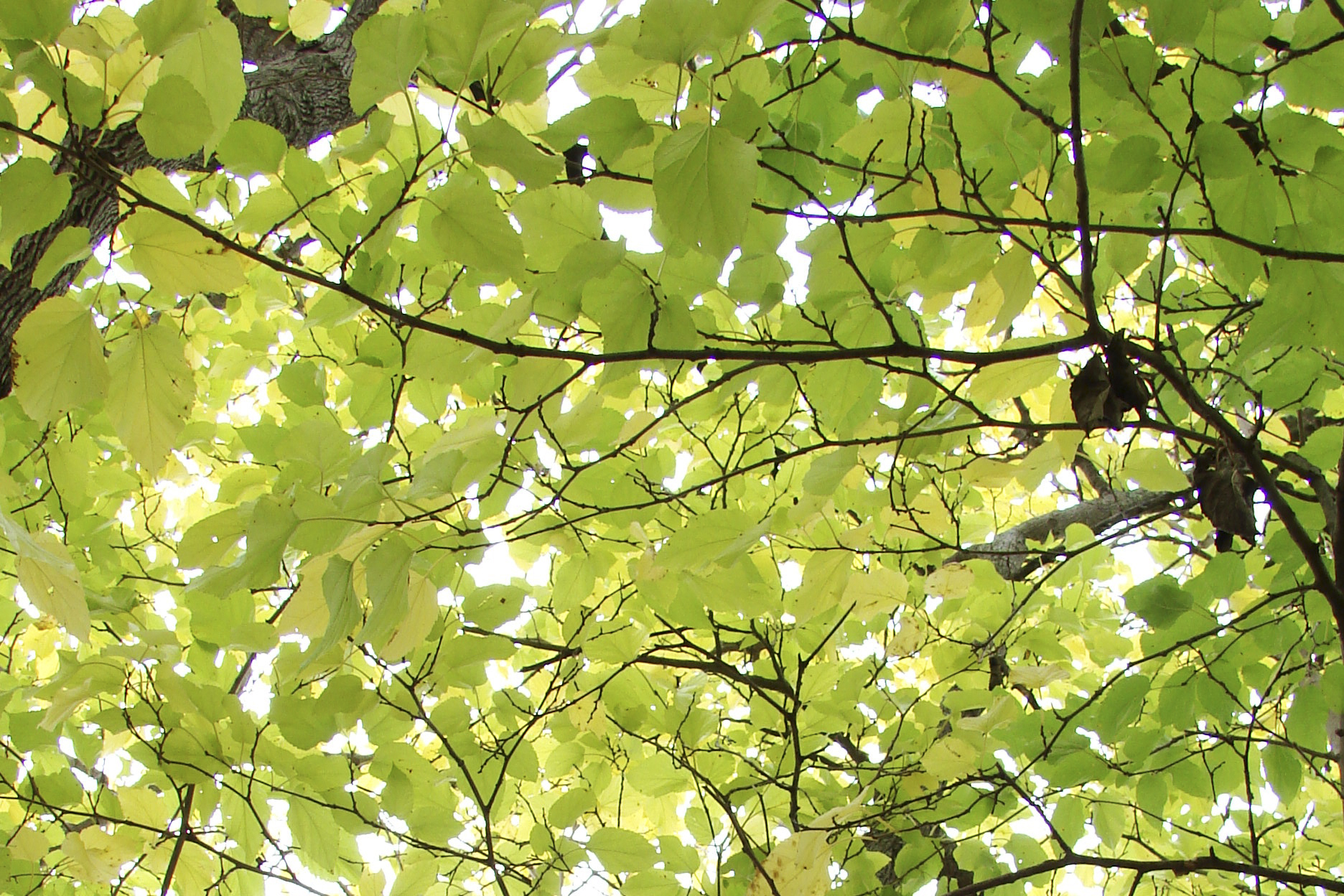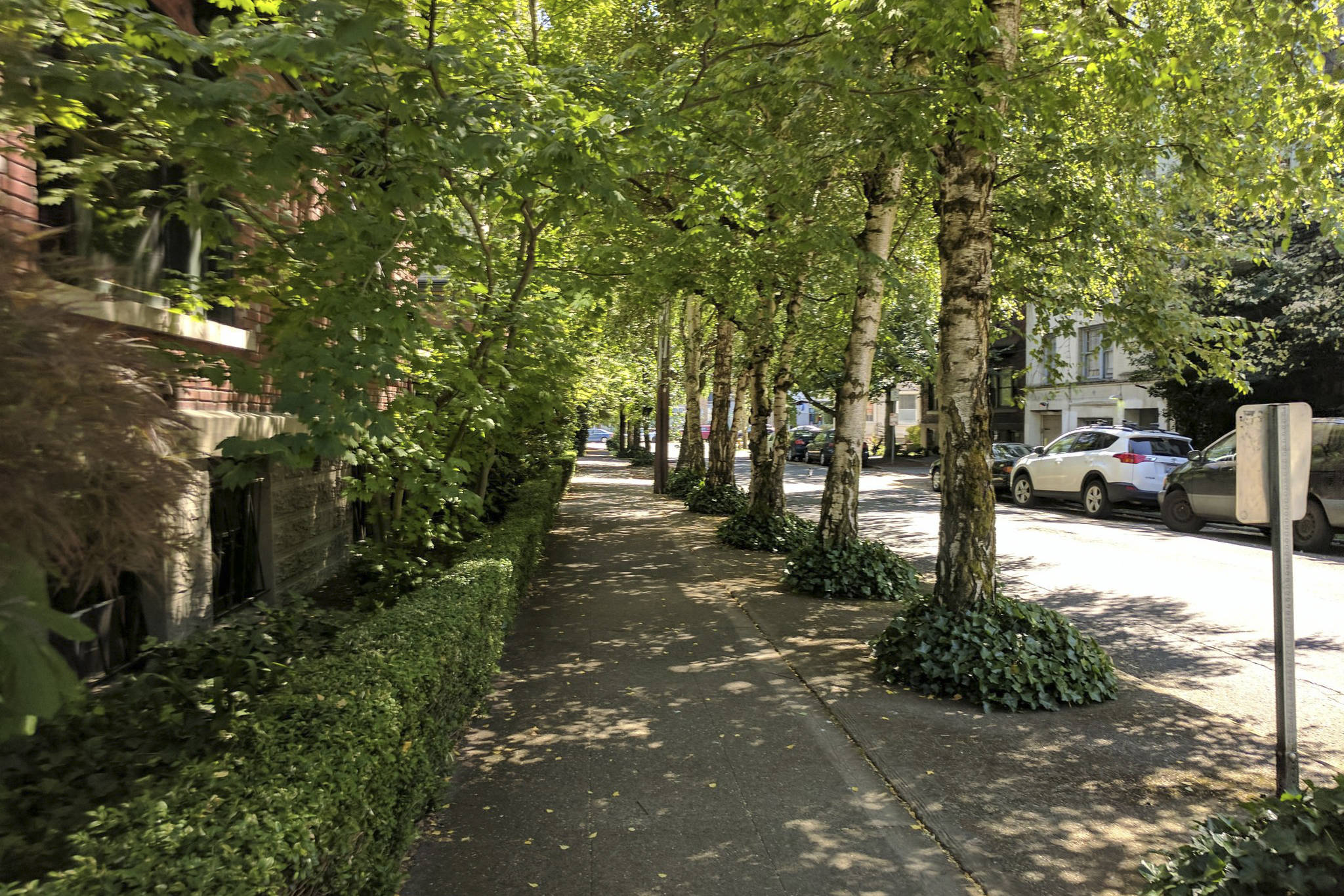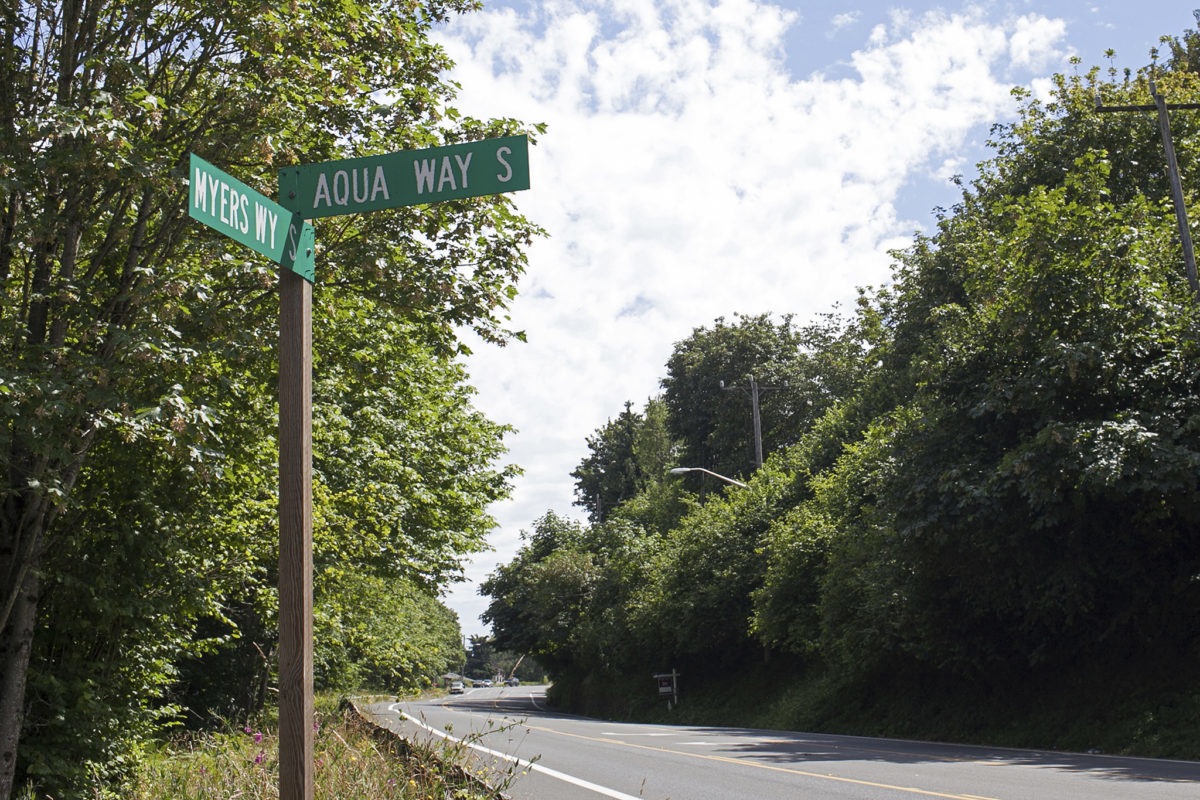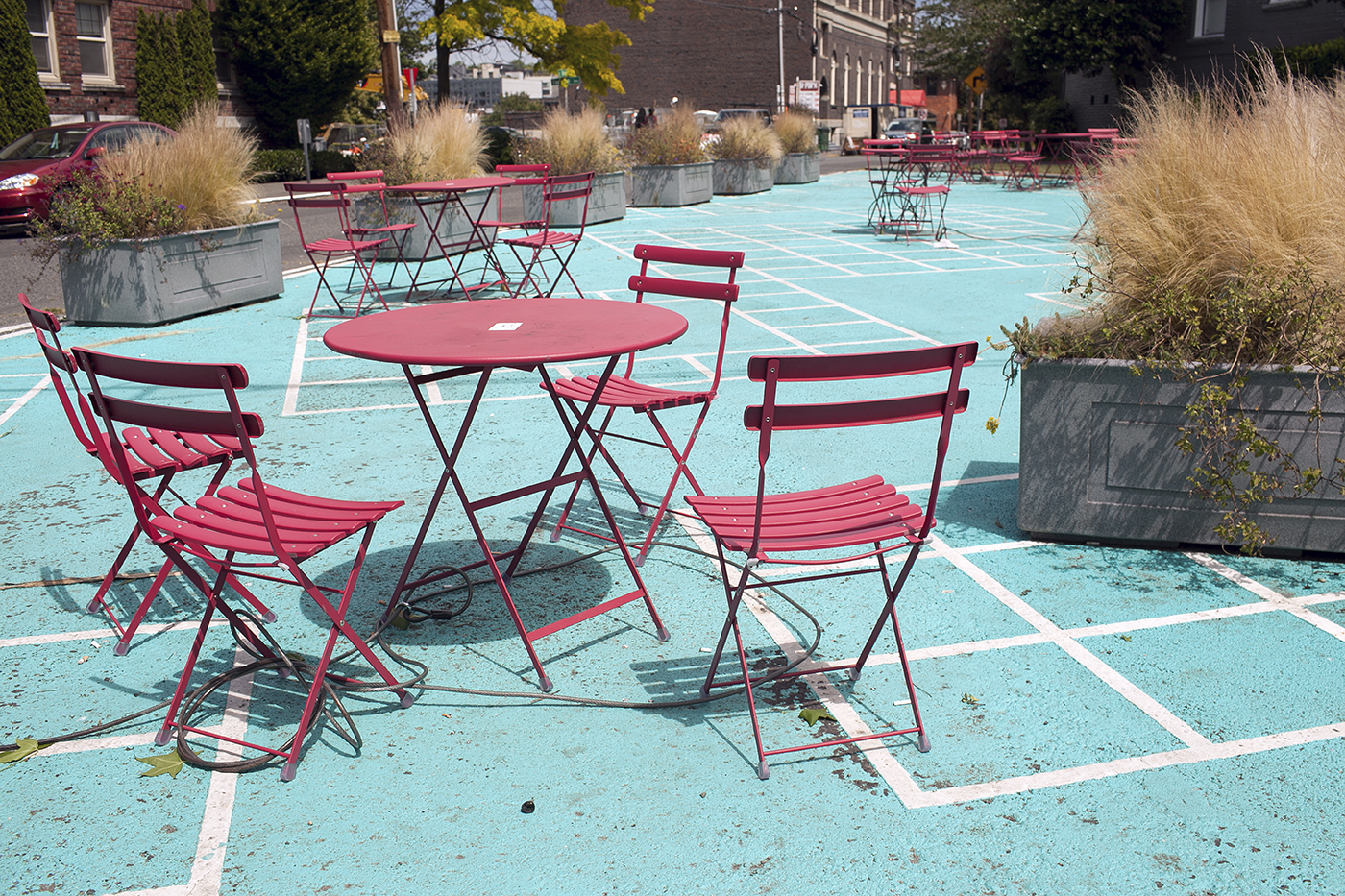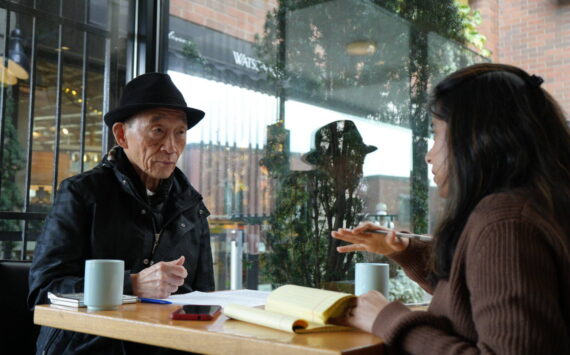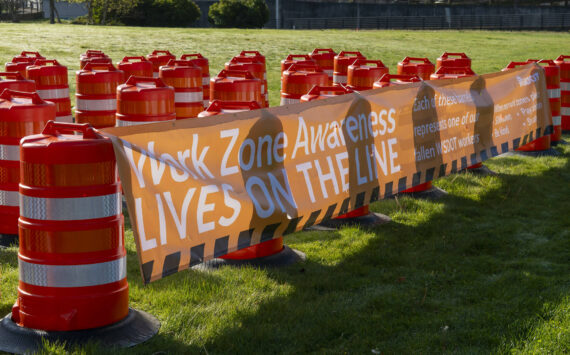Tawny Bates knows the trees in her neighborhood well. She points them out as she walks down the street on a recent afternoon. There is a big leaf maple, a chestnut, a willow, a blue spruce. These towering trees, she says, are in the crosshairs of development—eight of them, each roughly 40 feet tall, in a three-block radius in her little corner of Wallingford alone.
“You know, we used to have majestic old forests here,” she says, resting one hand reverently on a massive willow while holding a big binder containing a heavily-highlighted copy of the Seattle Land Use Code in the other. She speaks in a calm but impassioned voice as she describes the benefits that mature trees provide. They fight air and water pollution, she says, cool the neighborhood, and buffer residents from the urban din.
Bates and her fellow members of the Wallingford Community Council fear that these benefits could soon be lost as the city implements new development plans that they feel threaten to diminish Seattle’s tree canopy. “Do you think these are going to survive?” Bates asks as she gestures toward a blue spruce at the edge of her property. “No. They’re going to clear-cut Seattle again.”
Seattle’s urban canopy is of particular interest now because the city is considering adopting growth policies that would allow for more development. Bates and other tree advocates argue that the policies don’t sufficiently protect trees, pointing to a history of inaction by the city in protecting the Emerald City’s green umbrella. Existing tree protections on private property are ineffective, they say. And although the city said it would strengthen those rules, which affect more than half of Seattle’s tree canopy, little has been done. Meanwhile, city officials are unable to answer this simple question: Is the canopy growing or shrinking?
At issue is the 58 percent of the city’s urban forest that is located in single-family residential zones. These zones have become a major point of contention as the city explores options to increase density through both an update to the city’s Comprehensive Plan and the adoption of Mayor Ed Murray’s Housing Affordability and Livability Agenda. Single-family homeowners and neighborhood preservationists are concerned that the policies will pack too many people into their neighborhoods, diminish parking options, encourage gentrification, and result in a decline in general livability. That livability issue is where the tree canopy comes into play.
HALA proposes allowing the city to upzone single-family homes within a 10-minute walk of designated “urban village centers,” such as central Fremont and transit hubs like the planned Roosevelt light-rail station. If the Council decides to adopt HALA’s proposals, developers will be allowed to build higher and wider—sometimes all the way to the edge of the lot, leaving little to no room for trees. And for all its detail on development, the 76-page HALA proposal does not once make mention of trees.
The city has attempted to alleviate the pressures of development on the city’s trees, but the results have been wanting. Through its “Green Factor” credit system, the city awards points to different green elements of each new development. This system was designed to incentivizing developers to keep trees, but the city’s own Urban Forestry Commission was less than impressed. The commission found that Green Factor requirements could be met entirely with other landscaping measures, and was “not an effective tool for tree retention.”
The proposed changes to the Comprehensive Plan, which lays out broad goals for how Seattle will grow over the next two decades, have also triggered unease among those who preach the benefits of trees. The 2005 version of the plan, which is updated roughly every 10 years, set out to expand the tree canopy to 30 percent coverage of the city by 2037 and ultimately to 40 percent. It also called for “no net loss of canopy.”
In this go-round, the percentage goals remain, but the “no net loss of canopy” goal has been removed. City planners say it was redundant and that removing it signifies no change in policy, but neighborhood groups fear that without the “no net loss” language, it will be easier for the city to go back on its word in the future.
“This plan seems like it is development at all costs,” says Susanna Lin, a board member of the Wallingford Community Council who, with Bates, was one of several activists who showed up at a recent public hearing before City Council members.
As green as Seattle likes to portray itself to be, the city hasn’t much emphasized protecting its tree canopy. For a long time after non-Native settlers arrived, the idea was to cut down the trees. As the city re-greened itself through the 20th century, some of the canopy came back, but the city government didn’t pay much attention to tree policy until early this century.
Today, other cities are doing better by their trees. Atlanta, Austin, Portland, Vancouver, B.C.—why, even development-crazy Vancouver, Washington—have much stronger protections than Seattle. In all these cities, a homeowner must obtain a permit to remove a tree above a certain size, and must replace it. Portland even has an “inch per inch” rule, requiring that the size of the replacement tree corresponds with the size of the one lost, further protecting large trees. Not so in Seattle.
The City Council in 2009 launched an effort to get a handle on the loss of canopy on private land, ordering the Department of Planning and Development to draft a new tree policy. But when the draft ordinance emerged in 2010, the city’s year-old Urban Forestry Commission cut the proposal down to size, saying it was not nearly protective enough. That effort was further complicated by budget cuts and a lack of support from Murray and his predecessor, Mike McGinn. The City Council member championing the effort, Richard Conlin, was not re-elected. Inertia ensued, leaving only a bare-bones interim tree ordinance in place for the past seven years. It established that “exceptional trees” that are “of significant size or have historical, aesthetic, or ecological value” are protected. But there’s no systematic approach to enforcement, and little is happening.
“We just could not get quite the momentum and the problem-solving interest to get it done,” Conlin says now, adding that Murray still could make a difference. “It could definitely be an executive priority if the executive wanted to get involved in it.”
Critics note that when the city handed the chore of defending Seattle’s trees to the development-oriented DPD, it was putting the fate of the canopy in the hands of the city department perhaps least likely to take the job seriously. Despite marching orders from the Council, the agency never updated the 2009 interim ordinance.
“DPD just never did it. They just kept dragging their feet. I don’t think they ever took it seriously and never finished it,” says Matt Mega, who served on the Urban Forestry Commission from 2009 to 2012 as a representative of the Seattle Audubon Society.
The recommendations that emerged from the Urban Forestry Commission were outweighed by concessions to developers when draft legislation appeared, Mega recalls. Years later, he is seeing the results of that failure. “I think Seattle is in huge trouble right now,” Mega says. “Development is going in at a higher density factor, so that’s good, but I don’t think we’re preserving our trees as much as we should be.”
Creating strong, livable cities is a balancing act, says Bryce Yadon of the smart-growth advocacy group Futurewise. Density prevents urban sprawl, which has a lot of environmental health benefits, including reduced greenhouse-gas emissions and less water and air pollution. But density done right involves leaving some greenery intact within urban areas. “We don’t want it to be a fight between tree canopy and affordable housing,” Yadon says. “Trees are important, but density and housing people are extremely important. We can’t lose that sight either.”
The research is in. Urban trees are worth saving. The benefits of trees in cities are numerous. Cleaner air and water, reduced heating and cooling costs, and improved stormwater management are just a few of the better-known ones. But the full societal benefits of a healthy tree canopy extend beyond the environment and are just starting to be understood.
New research is finding that trees improve the health of humans around them to a greater degree than previously understood. Urban environments with more trees have populations with less stress and better immune responses. Symptoms of some mental-health conditions, such as attention deficit hyperactivity disorder in children and clinical depression, wane in the presence of trees, according to Kathleen Wolf, a research social scientist at the University of Washington School of Environmental and Forest Sciences. “We’re looking at a whole range of things that in the past we kind of took for granted,” she says. ”Now we’re seeing that that really should be a part of policy for urban forestry and green space.”
Then there are the numbers. According to the 2012 “Seattle Forest Ecosystem Values Report,” which was commissioned by the city, the replacement value of Seattle’s urban forest is estimated at $4.9 billion. This value, estimated through methods established by the Council of Tree and Landscape Appraisers, takes into account the hard costs of replacing the urban forest, as well as environmental factors. The report states that trees save the city government more than $11 million annually in carbon storage and sequestration and remove $5.6 million worth of pollution from the environment every year. The urban forest also reduces energy use in residential buildings, creating an annual savings of $5.9 million.
Maintaining this valuable resource is tricky. Seattle’s urban forest faces a unique combination of challenges, including narrow planting strips, rapid development, and the high value placed on unobstructed views, says City Arborist Nolan Rundquist, who manages trees on public land for the Seattle Department of Transportation. Root space is also crucial to building a large canopy, Rundquist stresses. But as yards get smaller, that space goes away.
“It takes a lot of space for a tree to thrive, especially a large tree,” says Andrea Mojzak, the tree-canopy expert at local sustainability nonprofit Forterra. Much of that space is underground, where root zones expand far wider than the trees themselves. These large urban trees are what Mojzak calls “superpowers in terms of ecosystem benefits,” providing far more bang for the buck than their smaller siblings.
Rundquist estimates that when a large, mature tree, such as a big leaf maple, comes down, it can take 30 or 40 years for two replacement trees to provide similar ecosystem benefits. That’s a big hit for the canopy, with long-lasting effects.
This difference of impact between large and small trees is one reason that measuring the overall tree canopy is challenging. Seattle’s current statistics are uncertain at best. Canopy assessments over the past 15 years have ranged from 23 percent city coverage to just below 30 percent. But because the studies were carried out with differing methodologies and varying levels of uncertainty, it’s not possible to accurately compare statistics over time.
The city’s urban-forestry experts at the Office of Sustainability and Environment are eager for the results of a new canopy-cover assessment. This assessment, due early next year, uses improved technology and will allow for the city’s first statistically significant comparison with previous figures.
But even that won’t be enough, says arborist and tree activist Michael Oxman. He argues that a citywide tree inventory is needed, one that would take tree size into account. “It’s a prerequisite to intelligent decision making,” Oxman says.
Such an inventory would be a huge and expensive undertaking. Though the idea has been proposed, the city balked at the cost. An inventory of the city’s street trees is underway, but it counts only trees on public land. When it is finished in a couple of years, the majority of the canopy still won’t be included.
“This is the town that Microsoft built, and if we can’t get a database of … trees, then we’re in pretty bad shape,” says Oxman.
As Steve Zemke pulled up to his house one afternoon a few years ago, he saw a man with a chainsaw about to cut down a 50-foot spruce at the corner of his yard. He was alarmed. It turned out his neighbors, tired of the spruce needles dropping on their roof, called a contractor with a chainsaw. Leaping out of his car, Zemke demanded: “What are you doing? That’s my tree!”
“If we had come home an hour later, that tree would have been gone,” Zemke says now. “And there’s no way in my lifetime that would have come back.”
Zemke, chairperson of Friends of Seattle’s Urban Forest and vice-chair of the city’s Urban Forestry Commission, says this kind of thing is happening all the time but hardly anyone is noticing. The solution he and the Forestry Commission advocate is to do what many other large cities already are doing: require a permit each time anyone cuts down trees above a certain size. Had that happened when the neighbor eyed the tree that turned out to be on Zemke’s land, Zemke would have spotted a notice on the tree—which is what happens, for two weeks, before trees on Seattle’s public lands can be felled.
Requiring permits would allow for better monitoring of tree removals and required replanting, says Tom Early, chair of the Urban Forestry Commission. “It’s best if we can at least have a good handle on what we have now and diminish its quick demise.”
The Forestry Commission argues that instituting a permit system would greatly decrease the number of trees people remove. Current city policy allows for up to three trees to be removed per lot per year, with no specification on size. And lots under 5,000 square feet are exempt from this rule, meaning many homeowners can remove whatever they like, whenever they like. The Commission recommended a permit system for removing trees in 2010, and Councilmember Conlin backed it. But the Department of Planning and Development wasn’t willing, saying it would be too expensive.
That, Zemke says, is the problem. Strong permit systems are where other cities have found success in regulating private-property trees. So why couldn’t Seattle make that happen? Zemke is ready to point the finger at the Department of Planning and Development (split last year into two agencies). “What you have is an inherent conflict of interest in a department that is asked to help people build things. And then you say you should also look at what you can do to protect trees,” he says. “They get money from building permits. They get no money from trees.”
Two years ago the Urban Forestry Commission asked Councilmember Sally Bagshaw to take up the issue in Conlin’s stead. Bagshaw has become the new champion of urban forestry on the City Council, says Sandra Pinto de Bader, urban forestry advisor at the Seattle Office of Sustainability and Environment. She has led the effort for a research project assessing the effectiveness of current private-property tree regulations. No efforts on a new ordinance have been started, though.
The Urban Forestry Commission will continue urging the City Council to dust off the unfinished tree regulations and get back to work, according to the commission’s 2016 work plan. Commission members are hopeful that the new data provided by the upcoming canopy-cover assessment and the study of current policy will spur a new tree ordinance. But by then Seattle’s 20-year growth blueprint will be law. Will Seattle’s tree canopy be merely an afterthought?
news@seattleweekly.com
InvestigateWest is a nonprofit newsroom based in Seattle and covering the environment, public health, and government accountability across Cascadia. Help support this kind of reporting at invw.org/donate.
This story has been modified to include more information about the Housing Affordability and Livability Agenda.
